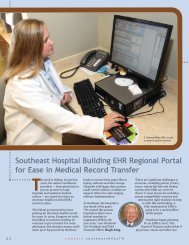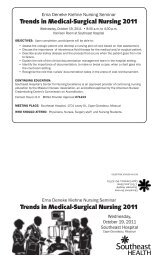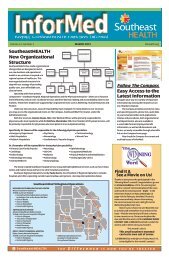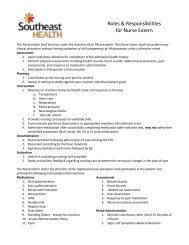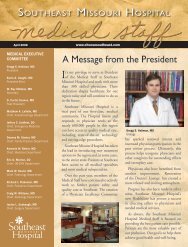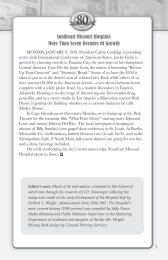Spirit of Southeast Management Award Recipients
Spirit of Southeast Management Award Recipients
Spirit of Southeast Management Award Recipients
Create successful ePaper yourself
Turn your PDF publications into a flip-book with our unique Google optimized e-Paper software.
The<br />
Shining<br />
I<br />
Star<br />
Café<br />
n <strong>Southeast</strong> Hospital’s newly remodeled cafeteria,<br />
“Fresh Inspirations” is more than just a new sign<br />
on the wall. It reflects a new philosophy <strong>of</strong> serving<br />
freshly made food and creating a dining experience<br />
for everyone from employees to visitors.<br />
“We don’t buy anything pre-made,” says J.D.<br />
Webster, director <strong>of</strong> Food & Nutrition Services at<br />
<strong>Southeast</strong> and one <strong>of</strong> two Executive Chefs. The<br />
bright green paint and modern signage convey an<br />
upbeat feeling in the Shining Star Café.<br />
A Vital Service<br />
Webster says the cafeteria is a vital service.<br />
“You can’t live without food,” he notes. And the café<br />
goes through a lot <strong>of</strong> food each year – 65,000 pounds<br />
<strong>of</strong> ground beef, 31,000 pounds <strong>of</strong> lettuce and 8,900<br />
pounds <strong>of</strong> chicken tenders.<br />
The cafeteria, which is part <strong>of</strong> Food & Nutrition<br />
Services, has about two dozen employees –<br />
everything from cooks to cashiers, who now sport<br />
colorful uniforms which were unveiled at the end<br />
<strong>of</strong> September. “We now have the full chef regalia,”<br />
Webster notes. Each uniform color identifies a<br />
different work station. Red is worn by those who<br />
grill food, black is for the kitchen cooks, white is for<br />
servers, green is for salad bar staff, brown is worn<br />
The newly-remodeled cafeteria boasts a fresh,<br />
updated feel to enhance the dining experience.<br />
At right, Sodexo resource manager Jerome O’Keefe<br />
shows the new serving area for hot entrées.<br />
The café goes Through a loT<br />
<strong>of</strong> food each year, including 65,000<br />
pounds <strong>of</strong> ground beef,<br />
31,000 pounds <strong>of</strong> leTTuce and 8,900<br />
pounds <strong>of</strong> chicken Tenders.<br />
by those who work the “Innovations” station where<br />
food is made to order. Cashiers wear tunics. It’s all<br />
part <strong>of</strong> the dining experience, Webster says.<br />
All Cooked Up<br />
There’s no shortage <strong>of</strong> mealtime. “We are<br />
open for breakfast, lunch, supper and late night<br />
(1:30 to 3:30 a.m.), Webster notes. “We start cooking<br />
at 5 a.m.” Breakfast is served, starting at 6 a.m.<br />
The café serves up an average <strong>of</strong> 35 breakfast<br />
sandwiches and 38 omelets a day. “We cook 35<br />
pounds <strong>of</strong> bacon and 15 pounds <strong>of</strong> sausage every<br />
morning.” The cafeteria crew bakes fresh biscuits<br />
three times each morning.<br />
The café recently began <strong>of</strong>fering waffles,<br />
serving more than 500 in the first month alone.<br />
Webster says the food is always fresh. “From the<br />
time it is cooked to the time it is sold is no longer<br />
than 15 minutes,” he adds.<br />
You won’t find any frozen pizzas here. “Our<br />
pizzas are hand tossed and hand rolled,” he points<br />
out.<br />
A Huge Shopping List<br />
The cafeteria has a huge shopping list. “We<br />
order in 700 pounds <strong>of</strong> produce three times a week.<br />
Café staff members from<br />
left: (front row) Grill Cook<br />
Brandon Olson, Relief<br />
Cook Angela Stephens,<br />
Cashier Debbie Slinkard,<br />
Cook Terri Mayberry,<br />
Cashier Sherry Welker;<br />
(second row) Executive<br />
Chef Kelly Fields, Deli<br />
worker Sharon Nelson,<br />
Director J.D. Webster,<br />
Clinical Nutrition<br />
Manager Rebekah<br />
Crowder, Retail Manager<br />
Nick Brown and<br />
Innovations Cook Jesse<br />
Bosecker.<br />
We order in over a ton <strong>of</strong> produce every week,”<br />
Webster says. That includes produce for patient<br />
meals. But the majority <strong>of</strong> the produce is used in the<br />
cafeteria which has an extensive salad bar.<br />
“We have over 35 items on our salad bar. We<br />
make our own fried onions, potato salad, tuna salad<br />
and chicken salad every day,” he notes. The café uses<br />
plenty <strong>of</strong> bananas too, some 360 pounds a week.<br />
The café dispenses over 400 gallons <strong>of</strong><br />
beverages a month, not counting bottled drinks.<br />
It goes through 58 cases <strong>of</strong> bottled drinks a week,<br />
Webster says. With 24 bottles in a case, that’s 1,392<br />
bottled drinks each week.<br />
Pleasing the Customers<br />
Customers <strong>of</strong> the Shining Star Café like their<br />
desserts too. “We sell on average 130 pieces <strong>of</strong> pie<br />
and pieces <strong>of</strong> cake and dessert bars every day,”<br />
Webster points out. “We sell 87 <strong>of</strong> the large cookies<br />
every day.”<br />
Since taking over as director in June, a whole<br />
new Food & Nutrition Services management<br />
team has been put in place. The café staff tries to<br />
accommodate the dining desires <strong>of</strong> every customer,<br />
he says. “If we have it available, we make it. Our job is<br />
to please the customer 200 percent.”<br />
Geese to Raccoons, Everything was<br />
Fair Game for Hospital Meals<br />
When <strong>Southeast</strong> Hospital first opened its<br />
doors, paying the grocery bill <strong>of</strong>ten was<br />
difficult. Hospital supporters routinely donated<br />
everything from butter to meat or money to pay<br />
the grocery wholesaler.<br />
Church groups stepped in to help, <strong>of</strong>fering<br />
to can fruits and vegetables grown in the<br />
Hospital gardens. With 25 cents <strong>of</strong> every Hospital<br />
dollar going to food (a main dish frequently<br />
served patients was 10-cents-a-pound bologna),<br />
donations <strong>of</strong> foodstuffs were eagerly accepted<br />
by the Hospital.<br />
In 1929, five hunters were apprehended<br />
with illegal game. Two contraband geese, two<br />
raccoons and 29 quail ended up in the Hospital’s<br />
cooking pots.<br />
The Hospital operated a chicken coop in<br />
its early years to provide a steady supply <strong>of</strong> eggs<br />
and poultry for patient meals. The chicken coop<br />
also allowed the Hospital to take poultry in lieu<br />
<strong>of</strong> money for patient bills.<br />
Patients <strong>of</strong>ten would pay their bills by<br />
turning over a dozen live hens, a piglet or boxes<br />
<strong>of</strong> sweet corn or tomatoes to the cashier.<br />
5




